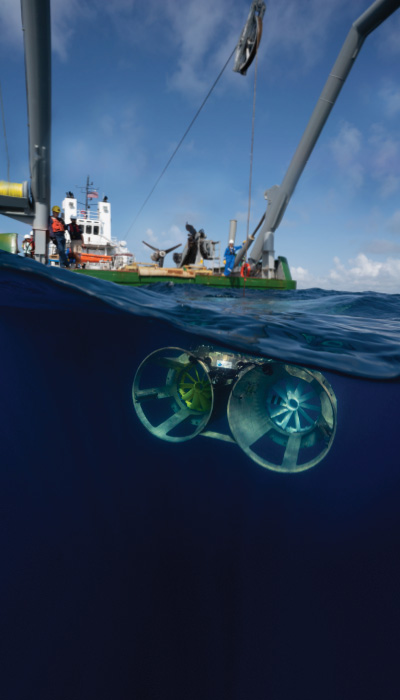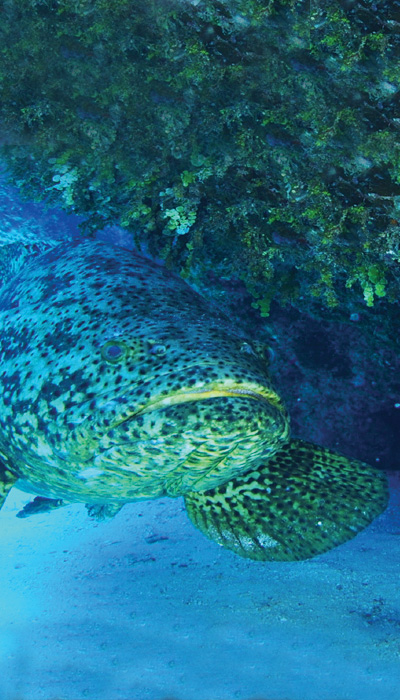Technological Innovation and National Defense
Defending our Coastlines

Engineering advanced technology is the overarching solution for uncovering the mysteries of deep-sea ecosystems and how they can benefit people, like revealing new sources for medical drugs, food and energy resources. It is important to providing enhanced security for all Floridians and United States citizens. FAU Harbor Branch works with major defense contractors and the U.S. Department of Defense on coastal security projects that improve the U.S. Navy’s ability to detect foreign enemies and other ocean-borne threats.
Exploring the Ocean and the drive to overcome the formidable technical challenges of ocean research was essential to the founding of Florida Atlantic University (FAU) Harbor Branch Oceanographic Institute by J. Seward Johnson Sr. in 1971. This spirit was embodied by Johnson’s friend, inventor Edwin A. Link, whose lifetime of innovation included the first flight simulator, the first diver lock-out submersible and the Johnson-Sea-Link submersibles. Discoveries enabled by Link’s work, such as Florida’s deep-water coral reefs and the collection and safeguarding of thousands of marine organisms used in FAU Harbor Branch drug discovery efforts, continue to shape our understanding and appreciation of the oceans.
"Since the beginning of oceanography in the early nineteenth century, the big advances have been the result of new developments in technology, which are like windows into the ocean that nobody’s ever seen before."
Michael Twardowki, Ph.D.
FAU Harbor Branch
Research Professor
More than 70% of the planet is covered by water. However, only a small percentage of the oceans have been studied. Technological advancements are allowing scientists to reach deeper depths of this mysterious realm and in new, noninvasive ways.
In addition to learning more about the natural world, uncovering the mysteries of deep-sea ecosystems can benefit people, like revealing new sources for medical drugs, food and energy resources, and even benefit the Nation’s coastline security.
Information from ocean exploration can also help predict earthquakes and tsunamis and help us understand how we are affecting and being affected by changes in the Earth’s environment.
- More than 70% of the planet is covered by water
- More than 80% of the ocean is unmapped, unobserved and unexplored
- “Florida current” portion of the Gulf Stream could generate between 4 and 6 gigawatts of power
- Less than 20% of the global seafloor has been mapped
- Florida’s military and defense industry provides $95 billion in economic impact

Inspired by Johnson and Link’s legacy, we develop revolutionary and cutting-edge technologies that enable us to discover, map, observe, quantify, sample and conserve the ocean’s diverse organisms and habitats.
Engineering advanced technology is critical to providing enhanced security across the Nation. FAU Harbor Branch works with major defense contractors and the U.S. Department of Defense to better understand the oceanic environment in which the Navy operates and the biological, chemical, and physical processes that regulate that environment. One research project is investigating the potential to use vocalizations from resident fish populations to warn against coastline invasion. As an added benefit, this important work also yields insights that inform overarching solutions for degraded coastal and ocean environments.
One of the world’s strongest currents, the Gulf Stream, flows at speeds up to 5.6 miles per hour and transports nearly four billion cubic feet of water per second from Florida to Europe. The Southeast National Marine Renewable Energy Center (SNMREC) is a U.S. Department of Energy recognized center at FAU, focused on the safe and responsible use of marine renewable energy from the Gulf Stream. The ultimate goal is to harness this extreme natural force to power some of Florida’s most populated coastal communities sustainably. At the core of SNMREC research is a novel ocean turbine prototype created and deployed by FAU Harbor Branch ocean engineers. The Institute is poised to take this technology from prototype to landing a permanent place within the Nation’s alternative energy portfolio.
The advent of Autonomous Underwater Vehicle (AUV) technology has dramatically increased the efficiency, frequency and depth of underwater exploration missions. AUVs are specialized robots capable of operating on their own using onboard computers, sensors and batteries. These instruments can conduct missions for months at a time, traveling vast distances and diving to depths of more than 18,000 feet. Scientists at FAU Harbor Branch develop and use specialized AUVs outfitted with advanced sensors to collect oceanographic data and study such topics as the physical features of the seafloor, ecology of deep-water coral reefs and endangered fish spawning aggregations.
Light is the foundation of life on the Earth and in the oceans. The color and clarity of seawater, as well as the dissolved and particulate materials suspended within it, play an important role in the transmission of sunlight through water. From images of microscopic particles to space satellite photographs of entire coastlines, the interdisciplinary team of ocean optics researchers at FAU Harbor Branch develop transformative optical technologies to gain better visibility and understanding of the critical processes within our oceans.
- Increased coastal security utilizing state-of-the art ocean engineering and applied technology
- Novel AUVs and sensor technology deployed for oceanography studies and exploration
- Enhanced visibility and understanding of the critical processes within our oceans
- Marine renewable energy generated by the Gulf Stream current as sustainable resource
"Resilience and disaster are the two faces of nature. And resilience continually adapts to new emerging threats. So technology inspired by resilience in nature is our best chance to make our lives safer in a changing world.”
Laurent M. Chérubin, Ph.D.
FAU Harbor Branch
Associate Research Professor
How You Can Help
Tools and technologies are critical in allowing scientists to reach farther depths of the ocean and answer previously unanswerable questions. Your support can expand ocean exploration capabilities, help uncover and safeguard their immeasurable resources for the benefit of humankind and secure our coastline from foreign-born threats.
Thank you for considering supporting this critical research area. Harbor Branch values our donors as key partners in helping to achieve our vision: “Ocean Science for a Better World®.”
"Marine science suffers because we can’t see through the water with precision. We need to take on this difficult task to expand the capabilities of modern, deep-sea exploration.”
Derya Akkaynak, Ph.D.
FAU Harbor Branch
Senior Research Fellow
